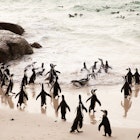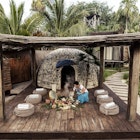
The world's most remote island is now the Atlantic's largest marine park

Nov 18, 2020 • 2 min read

The waters around Tristan da Cunha will become the Atlantic's largest marine protection area ©Getty Images
In a massive win for conservation, the tiny island of Tristan da Cunha is creating a marine protection zone that will make it the largest sanctuary in the Atlantic and the fourth-largest in the world.
- placement: fullWidth
- path: articles/in-content-top
- possible size: [970, 250], [970, 90], [728, 90], [300, 250], [320, 50], [1, 1],
- targeting:
{ "url": "tristan-da-cunha-marine-park" }
Tristan da Cunha is a British Overseas Territory in the South Atlantic that's home to just 254 residents. It's the most remote inhabited island on Earth, but soon it will have another unique claim to make when it becomes the largest fully protected marine park in the Atlantic. The UK government announced that almost 700,000 square km of the waters around Tristan da Cunha will become a marine protected area where bottom-trawling fishing, deep-sea mining and other harmful activities will be banned.

- placement: fullWidth
- path: articles/in-content-middle
- possible size: [970, 250], [970, 90], [728, 90], [300, 250], [320, 50], [1, 1],
- targeting:
{ "url": "tristan-da-cunha-marine-park" }
The archipelago is home to many unique species including Southern right whales and their calves, the elusive shepherd's beak whale, sevengill sharks, the globally-threatened blue-nose albatross, and the Atlantic petrel, as well as 80% of the world's population of sub-Antarctic fur seals, and 90% of the world's population of Northern rockhopper penguins. Tens of millions of seabirds feed here too. The sanctuary will go a long way in safeguarding local and visiting wildlife and will help the UK reach its target of protecting 30% of the world's oceans by 2030 through its Blue Belt Programme.

“Our life on Tristan da Cunha has always been based around our relationship with the sea, and that continues today,” James Glass, the territory’s chief islander, said in a statement. “That’s why we’re fully protecting 90% of our waters, and we’re proud that we can play a key role in preserving the health of the oceans.”
- placement: native
- path: articles/in-content-native
- possible size: [f, l],
- targeting:
{ "url": "tristan-da-cunha-marine-park" }

The isolated area is located about halfway between South Africa and Argentina. It is made up of four islands including Inaccessible Island, Nightingale Island, and the UNESCO World Heritage Site of Gough Island. Most of the islands' income is supported through sustainable rock lobster fishery.
The archipelago doesn't have an airport. The only way to travel there is by ship from Cape Town and visitors need prior approval from the Tristan da Cunha council.
You might also like:
Tristan da Cunha: a journey to the centre of the ocean
Sustainable tourism, wildlife protection and Indigenous culture thrive in Australia's new marine park
Record amount of plastic recovered from largest-ever ocean clean-up
- placement: fullWidth
- path: articles/bottom
- possible size: [970, 250], [970, 90], [728, 90], [300, 250], [320, 50], [1, 1],
- targeting:
{ "url": "tristan-da-cunha-marine-park" }
Explore related stories

National Parks
Protecting rhinos from poachers in Africa - what it's like working on the frontlineAug 23, 2022 • 10 min read

 Wildlife & NatureEnjoy the simple life at these 10 top agritourism farm stays
Wildlife & NatureEnjoy the simple life at these 10 top agritourism farm staysMar 16, 2022 • 7 min read
 Wildlife & NatureHow to find an ethical wildlife conservation project for your next trip
Wildlife & NatureHow to find an ethical wildlife conservation project for your next tripMar 3, 2022 • 4 min read
 National ParksRewilding in Argentina's ecotourism hotspot saved these giant river otters
National ParksRewilding in Argentina's ecotourism hotspot saved these giant river ottersJul 7, 2021 • 5 min read

 Sustainable TravelAirbnb wants to help travellers interact ethically with animals
Sustainable TravelAirbnb wants to help travellers interact ethically with animalsOct 4, 2019 • 2 min read

 Sustainable TravelThe top 10 countries in the world for conservation have been revealed
Sustainable TravelThe top 10 countries in the world for conservation have been revealedMay 15, 2017 • 3 min read
 HikingUltimate travel list: Lonely Planet's top sights in the world (41 to 50)
HikingUltimate travel list: Lonely Planet's top sights in the world (41 to 50)Aug 17, 2015 • 6 min read
